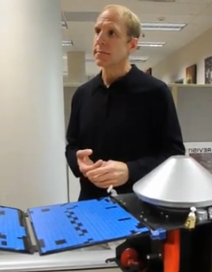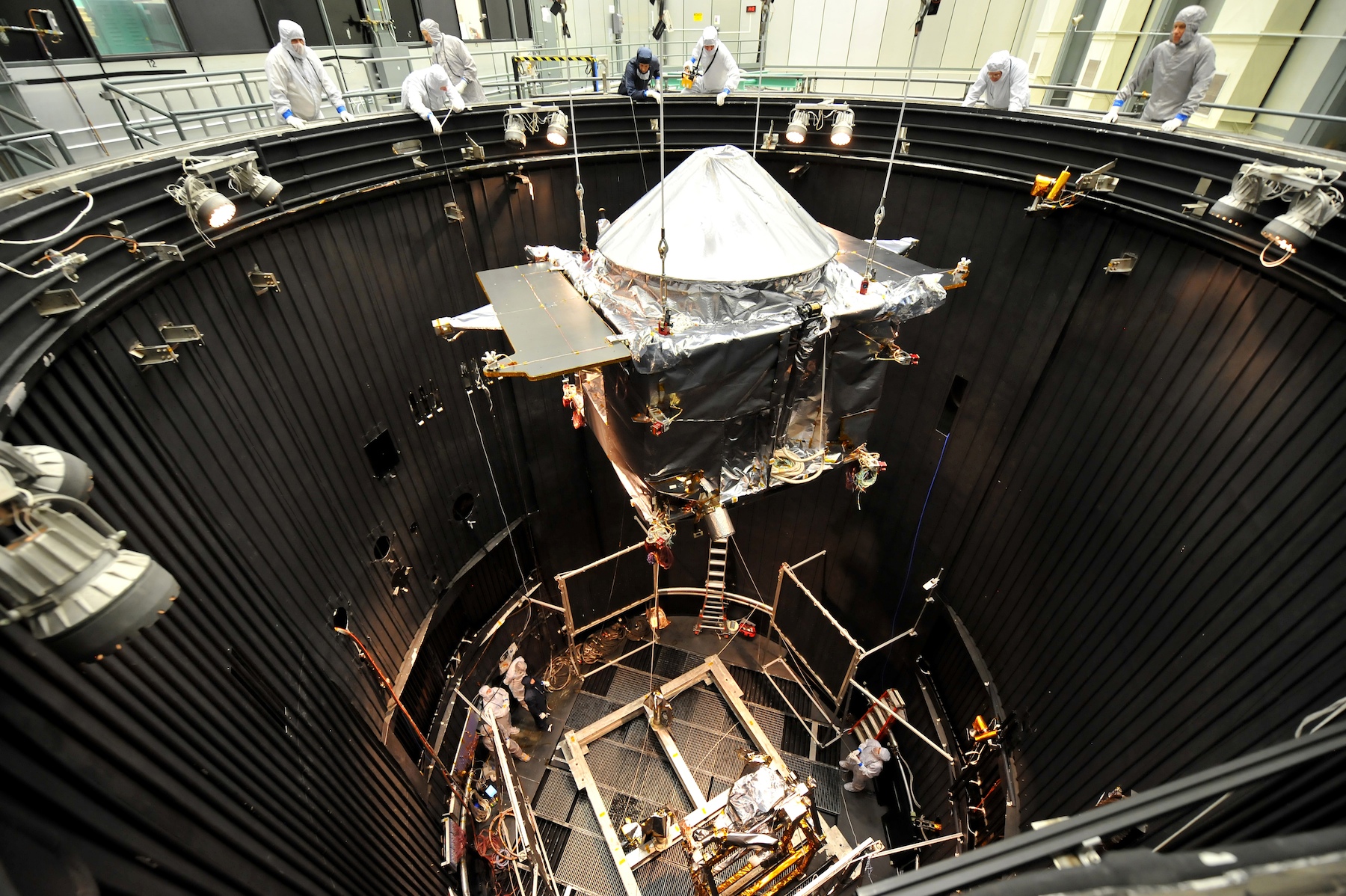At 1:28 p.m. EST, the MAVEN spacecraft began its 10-month journey to Mars orbit, launching aboard a United Launch Alliance Atlas V rocket from Cape Canaveral Air Force Station in Florida.
The Atlas V and the spacecraft have performed flawlessly in the early hours after launch. MAVEN’s “gull wing” solar arrays have deployed, sending power to the instruments onboard, and mission ground support personnel have confirmed the receipt of telemetry, indicating that communications with the spacecraft are proceeding as expected.
As of Nov. 25th, MAVEN operations are going smoothly with all spacecraft systems healthy. MAVEN uses 24-hour Deep Space Network communications coverage and all communication events have been nominal.
The mission is now in its early cruise mission phase and the spacecraft is approximately 1.39 million miles (2.24 million kilometers) from Earth. MAVEN’s current Sun-centered speed is 73,497 mph. The next big milestone for the team is a planned trajectory correction maneuver (TCM) on Dec. 3, followed by the power up of the eight science instruments between Dec. 4 and Dec. 10.
“Thus far the MAVEN spacecraft has flown and operated as we had all hoped and planned,” said David F. Mitchell, MAVEN project manager. “There are some big events coming up in the days ahead but I couldn’t be more pleased with how the journey has started.”
Tuesday, December 3, 2013
Friday, June 21, 2013
Environmental Testing
Guy Beutelschies is
the Chief Systems Engineer at Lockheed Martin Space Systems Company and MAVEN
Flight Systems Manager
How do you make sure a spacecraft can survive in space? Facing the sun, surfaces can get hotter than any desert. In the shade, it is colder than any winter in Antarctica. The vacuum of space can wreak havoc if you don’t use the right materials. Launch is even tougher. If you‘ve ever been lucky enough to see a launch in person, you can feel the vibration rumbling in your chest from over a mile away. Now imagine what the spacecraft is experiencing as it sits on top of that “controlled explosion.”
The answer is
testing, lots of testing. We
arrange the tests in roughly the same order as the spacecraft will experience
in its mission. That means we do
launch first. It may not be
readily obvious, but the sound during launch is so intense that it can actually
break things. To simulate this, we
put the spacecraft in a special test chamber with enormous speakers and crank
up the sound to deafening levels.
Although it is tempting to play some Led Zeppelin, we use a noise
spectrum that simulates the Atlas V rocket firing.
The next one is
a vibration test. We put the
spacecraft on a large device called a shaker table that moves a plate back and
forth to provide the vibration that the vehicle will get on the rocket. After shaking it in the horizontal
axes, we rotate the piston-like device on the shaker table so that it moves the
spacecraft up and down. It wasn’t
easy for me to see the spacecraft we’ve spent so much time carefully building
being shaken like that, but it was important to do.
Soon after
launch, we will then deploy the solar arrays. This is a tricky test on Earth because of the gravity down
here. We need to make sure gravity
is not “helping” the arrays deploy during our ground testing. To mitigate this, we turn the
spacecraft and deploy the arrays to the side so that the hinges are
perpendicular to the ground. We
also used special stands to support the weight of each array while allowing
them to move freely across the floor as they deploy. We follow the same process for deployment tests on the
Articulated Payload Platform boom and the Solar Wind Electron Analyzer boom.
The third major
environmental test involves radio waves.
Most of our regular tests use cables between the ground equipment and
the spacecraft to send commands and receive telemetry. During the mission, our only link to
the spacecraft is through radio signals.
For this test, we set up a special acoustics chamber to block out all
outside radio signals that might interfere, and then use special ground
antennas to talk to the spacecraft antennas as if MAVEN were out in space. The tests also make sure that the various portions of the
spacecraft do not interfere with each other and that the radio waves from the
ground do not interfere with equipment on the spacecraft.
The final
environmental test is our biggest one.
The MAVEN spacecraft is put in a thermal vacuum chamber; think giant
thermos bottle. Once inside, we
pump out the air and flood the hollow walls with liquid nitrogen which brings
the temperature down to -290 degrees Fahrenheit. Giant lamps in the ceiling simulate the direct heat
from the sun. This test makes the spacecraft “feel” as if it’s in space. We
spend several weeks in vacuum simulating the entire mission from the heat of
the sun you get being near Earth, to the cold it will experience in the shadow
of Mars. It is almost as tough on
the team as it is on the spacecraft because the test consoles need to be
monitored around the clock for the entire test. That is a lot of evenings, weekends, and graveyards
shifts.
This regimen of environmental testing may sound like a lot of work, but after spending years designing and building it, we want to make sure everything work correctly. If something needs to be fixed, we want to learn about it while it here on the ground. Once we launch, there is no bringing it back to the shop for repairs. These tests give us a lot of confidence that MAVEN will be ready for its launch on November 18th.
With the recent completion of thermal vacuum testing, the MAVEN spacecraft has now successfully completed and passed all of its environmental test procedures. The team will now focus on the remaining Launch Operations Readiness Tests (ORTs), a final Planetary Protection review, and a spacecraft pre-ship review in preparation for shipping MAVEN to Cape Canaveral, Florida, in early August.
Tuesday, April 23, 2013
A conversation about Education and Public Outreach
Stephanie Renfrow, MAVEN Education & Public Outreach lead & Laura Peticolas, EPO co-lead |
Stephanie Renfrow (left) and Laura Peticolas lead education and public outreach efforts on behalf of MAVEN. In this joint post, the two leads discuss the program and what it means to them. (Courtesy MAVEN)
Let’s start by asking a question: how is it that you know about Mars and current space exploration? For example, how did you come to find this blog posting?
The MAVEN Education and Outreach program is MAVEN’s way of reaching out to the public, students, and educational audiences to share the excitement and learning-power that surrounds a mission of this size. We do this through social media, classroom programming, teacher professional development, public lectures, museum programs, and every other way we can think of to spread the word. Do you ever wonder, who are the people who bring that information to you online, to the staff at the museums you visit, or to the teachers who spend time with your children?
In a nutshell, the answer is: that’s us! The EPO team for MAVEN works to find ways to bring the mission to you through every possible avenue (except via traditional journalists, which is the purview of Public Affairs). We are in many ways translators and educators. We translate the mission, engineering, and science in ways that teachers, afterschool providers, museum/science center staff, and others can use.
So, for MAVEN, we first did some research to uncover what audiences would most benefit from learning about Mars’ atmosphere. This research, together with our team’s expertise, gave us a starting point in selecting partners and projects to develop a full education and public outreach plan. With the plan reviewed, tweaked, and approved, we’ve been able to use it as our blueprint in developing and implementing the program you see.
We also work hard to understand perspectives from many different people and learn in what ways other NASA Mars missions have been successful in engaging people, perhaps people like you. We even tap into our non-science circles from time-to-time. Both of us talked extensively with family and friends about the Mars Curiosity rover and how it connects to what we do. While our personal networks “rediscovered” our professional lives as they asked us questions, we learned what Curiosity educational activities really caught their attention and made them want to learn more. We now can apply what we learned from these conversations and many others with people from around the country into our own MAVEN educational programs.
In addition to enjoying the opportunity to answer everyone’s questions, the Curiosity landing served as an incredible reminder for just how exciting exploration of Mars is to millions of people. In our view, we have the best job on the whole mission: we get to share how your tax payer dollars take us to new scientific and technical heights, while finding meaningful ways to connect with your sense of wonder and facilitate making personal ties to science and the learning process. It is thrilling to explore Mars. It is thrilling to share the new discoveries to kindle real people’s excitement for science and exploration!
Over the coming months, we’ll be highlighting some of our EPO programming here on the blog—stay tuned to learn more, and in the mean time, visit “Education & Outreach” at http://lasp.colorado.edu/maven!
Subscribe to:
Posts (Atom)



